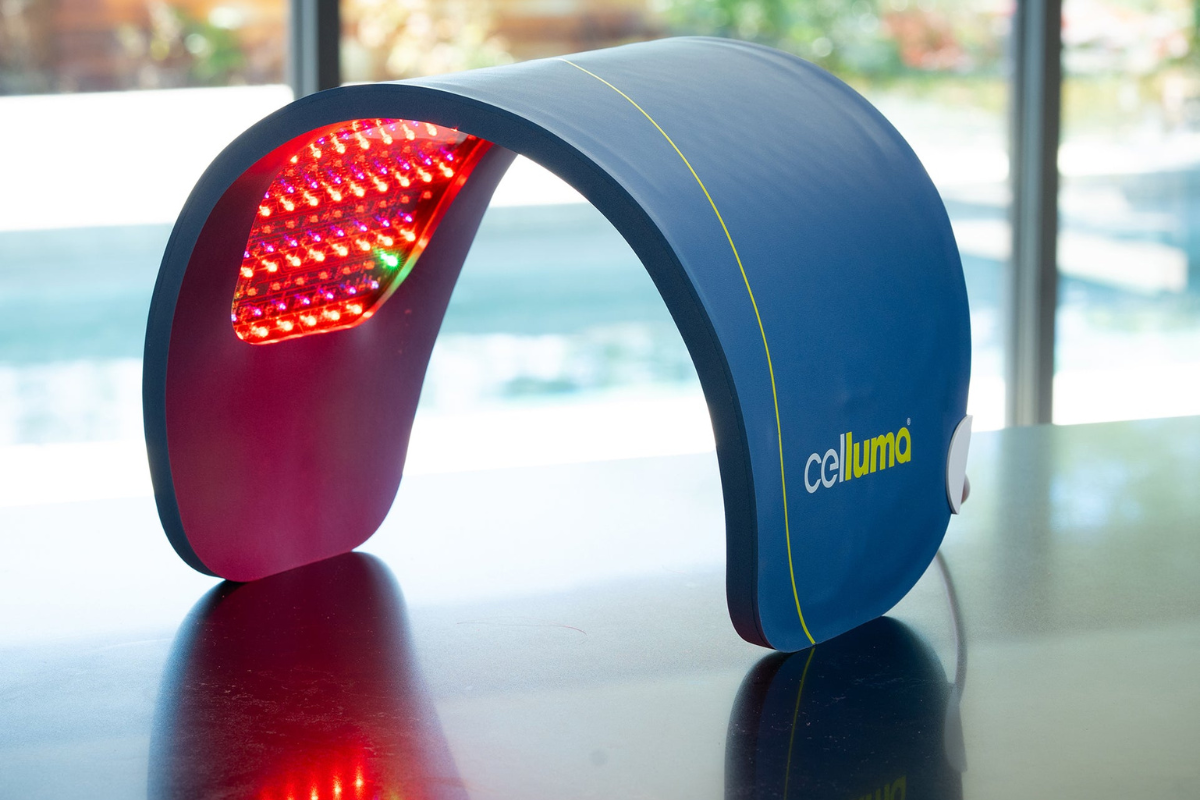Red Light Therapy: What It Really Does for Your Skin & Body
🌿 Why Red Light Therapy Deserves a Spot in Your Routine
I started using red light therapy for skin and body as part of my own wellness routine after seeing it firsthand in a professional setting. When I worked in a plastic surgery medical spa, we used the Celluma Pro device to help patients recover after procedures—minimizing swelling, supporting collagen, and speeding up healing. It wasn’t some trendy gadget—it was part of their post-surgical care plan, and patients absolutely loved it.
Now that I’m using it at home, it’s become one of those quiet rituals that just fits into my mornings. Funnily enough, my teens grab this from my room all the time to use the blue light setting on the Celluma Pro several times a week for acne—and we’ve all seen real results. It’s one of the few things that consistently calms their breakouts without drying out their skin. And honestly, the science behind this device is just as impressive as the results.
This post breaks down what red light therapy for skin and body is actually doing, why it’s not just hype, and how to use it in a way that makes sense for your lifestyle. Whether you’re curious about collagen, inflammation, acne, or even off-label uses like hair regrowth or skin firming, you’re in the right place.
🛒 click image to shop:
How Red Light Therapy for Skin and Body Actually Works
Now that we’ve covered the vibe and why this matters in daily life, let’s dig into what red light therapy is actually doing on a cellular level. At first glance, red light therapy might sound a little… out there. But here’s the deal: it’s grounded in real science—and the results are well-documented.
Red light therapy (also called low-level light therapy or photobiomodulation) works by using specific wavelengths of light—typically red (around 630–660nm) and near-infrared (around 800–850nm)—to stimulate your body at the cellular level.
🧠 The science in plain English:
When these wavelengths penetrate your skin, they reach the mitochondria—your cells’ little energy factories. That light helps your mitochondria produce more ATP (adenosine triphosphate), which is basically energy for your cells to function better. More ATP = better cell repair, collagen production, circulation, and inflammation control.
What’s especially interesting is that Celluma’s studies back this up—one showed that red light therapy significantly accelerated wound healing by increasing microcirculation and stimulating fibroblast activity (which supports tissue repair and collagen production). Another documented a measurable reduction in inflammation and pain in patients using red and near-infrared wavelengths for musculoskeletal recovery. You can explore their clinical research here.
🔎 Quick Breakdown: What Red Light Does
- Boosts energy production at the cellular level (ATP)
- Reduces inflammation
- Stimulates collagen and elastin
- Improves circulation
- Supports healing post-injury or post-surgery
Whether you’re looking to support post-op healing, calm inflammation, brighten your skin, or ease muscle tension, red light therapy gives your body the fuel it needs to do what it’s already designed to do—just better.
✨ The SKIN Benefits of Red Light Therapy
So how does all of that cellular magic translate into real changes you can see? Let’s break down what red light therapy can do for your skin. Let’s talk skin—because this is where red light therapy really shines (literally and figuratively).
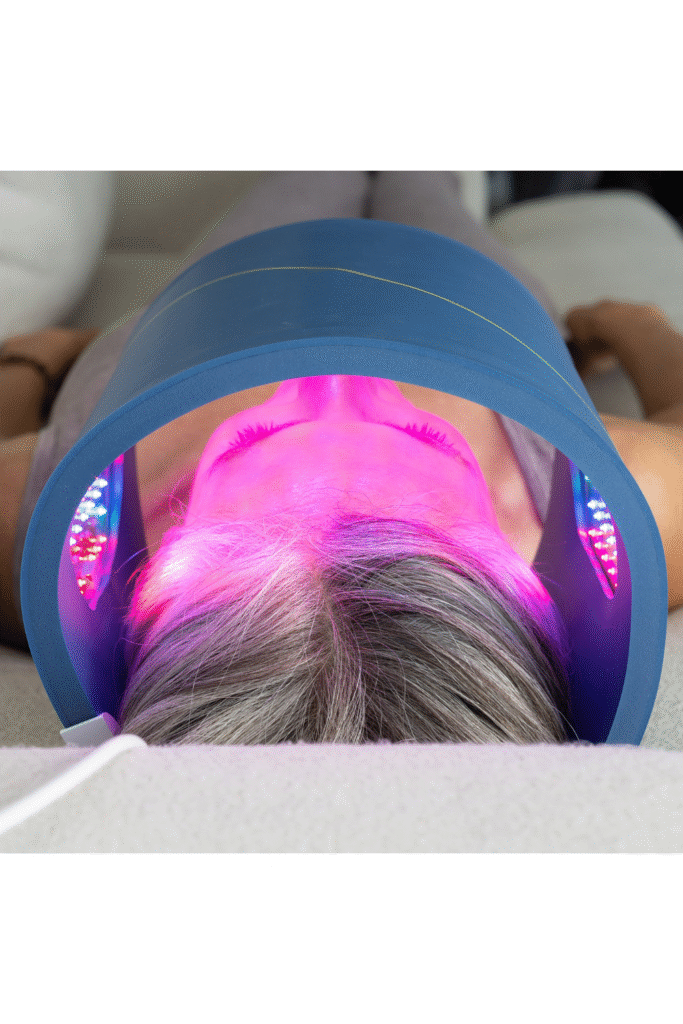
For years, red light therapy has been studied for its effects on the skin—from fine lines and wrinkles to acne, redness, and texture. And while it might seem like just another “anti-aging” trend, the science is solid.
What red light therapy is really doing is supporting your skin’s natural repair process—helping it function at its best from the inside out.
1. It Stimulates Collagen + Elastin Production
Red light therapy encourages fibroblast activity, which is responsible for producing collagen and elastin—aka the proteins that keep your skin smooth, firm, and resilient.
Over time, this can help:
- Reduce the appearance of fine lines and wrinkles
- Improve skin elasticity
- Make skin look plumper and more youthful
📚 One Celluma-backed study showed an increase in collagen synthesis and fibroblast activation within 24 hours of treatment, helping improve skin density and reduce visible signs of aging.
🧖♀️ My take: I’ve personally noticed that my skin feels smoother and more hydrated when I’m consistent with red light sessions, especially when I combine it with my regular skincare routine.
2. It Calms Redness + Inflammation
If you deal with rosacea, sensitivity, or post-acne inflammation, red light therapy can help. By improving microcirculation and reducing oxidative stress, it helps calm down the skin and speed up the healing process.
- Less redness
- Faster fading of post-breakout marks
- Overall healthier tone and texture
📚 A clinical trial found that red light therapy significantly reduced erythema (skin redness) and inflammation markers in as little as 2–4 weeks with regular use.
3. Blue Light Mode Helps Treat Acne (Especially for Teens)
The Celluma Pro device includes blue light (around 415nm), which is designed to target acne-causing bacteria (P. acnes) on the skin’s surface. My teens use this several times a week, and it’s made such a noticeable difference in calming breakouts—without the harsh dryness that comes with many acne treatments.
- Reduces breakouts by killing bacteria
- Helps prevent new pimples from forming
- Gentle and non-irritating
👩👧👦 Real-life note: Blue light has become a staple in our house. It’s one of the few things that consistently helps my teens manage breakouts without over-drying or irritating their skin.
Even better? Their friends are now asking what they did to clear up their skin—and how they can too. It’s sparked more than one “Okay, I need that thing your mom has” conversation.
4. It May Improve Hydration + Overall Glow
Red light therapy helps improve circulation and lymphatic flow, which means your skin gets more oxygen and nutrients—resulting in that subtle, healthy glow.
While it’s not going to replace your skincare products, it does support your skin barrier and water retention over time.
✨ Tip: I love using red light after applying my hydrating serum and moisturizer—it seems to help everything soak in better and makes my skin feel extra refreshed.
Summary: What It Can Do for Skin
| Benefit | What It Does |
|---|---|
| Fine lines & wrinkles | Stimulates collagen & elastin |
| Acne | Blue light kills P. acnes bacteria |
| Redness & sensitivity | Calms inflammation & supports healing |
| Glow & tone | Boosts circulation + oxygen flow |
🧘♀️ The BODY Benefits of Red Light Therapy
Thankfully, the benefits don’t stop at your face. Red light therapy has become one of my favorite tools for supporting the rest of my body too—from recovery to inflammation relief. While red light therapy is often marketed for glowing skin and anti-aging, it goes way beyond that.
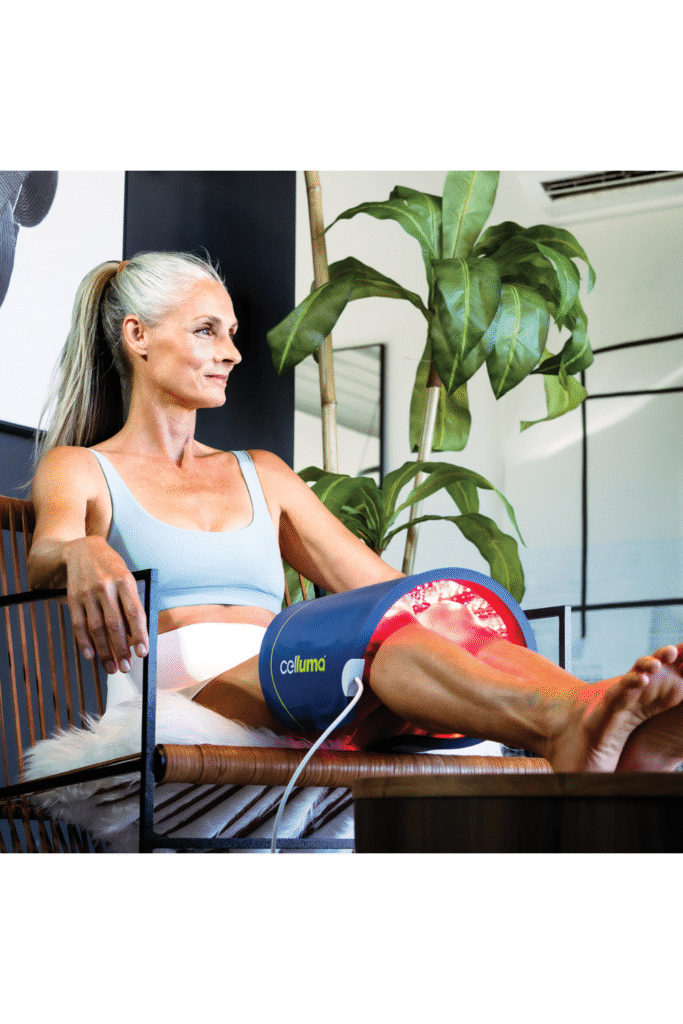
In fact, when we used the Celluma Pro in the plastic surgery medical spa I worked at, the focus wasn’t just cosmetic—it was functional. We used it post-surgery to reduce swelling, promote healing, and ease discomfort.
That experience completely reframed how I think about red light therapy: it’s not just a skincare tool—it’s a whole-body support system.
Here’s how the science—and the real-world results—back that up:
1. Reduces Inflammation + Aids Recovery
One of the biggest benefits of red light therapy is its ability to reduce chronic and acute inflammation. Whether you’re recovering from surgery, an injury, or dealing with systemic inflammation (like autoimmune flares or muscle tension), red light helps your body repair more efficiently.
📚 In a 2020 Celluma clinical trial, patients using red light therapy post-operatively reported faster healing and reduced swelling compared to control groups.
🔄 Real-life insight: Many of our patients in the med spa felt noticeably more comfortable after sessions—and healing timelines were often shorter.
2. Supports Mitochondrial Function (Think: Energy & Mood)
Red and near-infrared light penetrate deep into the body and stimulate mitochondria, the “powerhouse” of your cells. This boosts ATP production (cellular energy), which may translate into more physical energy, better mood, and even improved sleep quality.
- May improve mental clarity and focus
- Can help regulate circadian rhythms when used in the morning
- May support a balanced nervous system (especially paired with calming routines)
📚 A 2018 study in the Journal of Photomedicine found that near-infrared light exposure led to improvements in energy metabolism and resilience to oxidative stress.
☀️ Jess tip: I like using my Celluma Pro light early in the day—almost like a ritual to “charge up” for the morning. It’s subtle, but I notice the difference when I skip it.
3. May Relieve Joint & Muscle Discomfort
If you’ve ever had tight shoulders, sore knees, or a stiff lower back, red light therapy might become your favorite tool. Whether you’re an athlete, an active walker, or simply noticing the effects of aging, this gentle treatment offers real support.
By improving circulation and reducing inflammation in the tissues, it can help:
- Soothe soreness after workouts
- Support recovery from chronic pain
- Improve range of motion over time
📚 Red light therapy has been FDA-cleared for temporary relief of muscle and joint pain, arthritis, and muscle spasms—based on well-documented clinical evidence.
4. Off-Label + Specialized Use: Hair Growth & Skin Firming
While the Celluma Pro is FDA-cleared for treating pain, acne, and wrinkles, it’s also commonly used off-label for other cosmetic goals—like hair regrowth and skin firming.
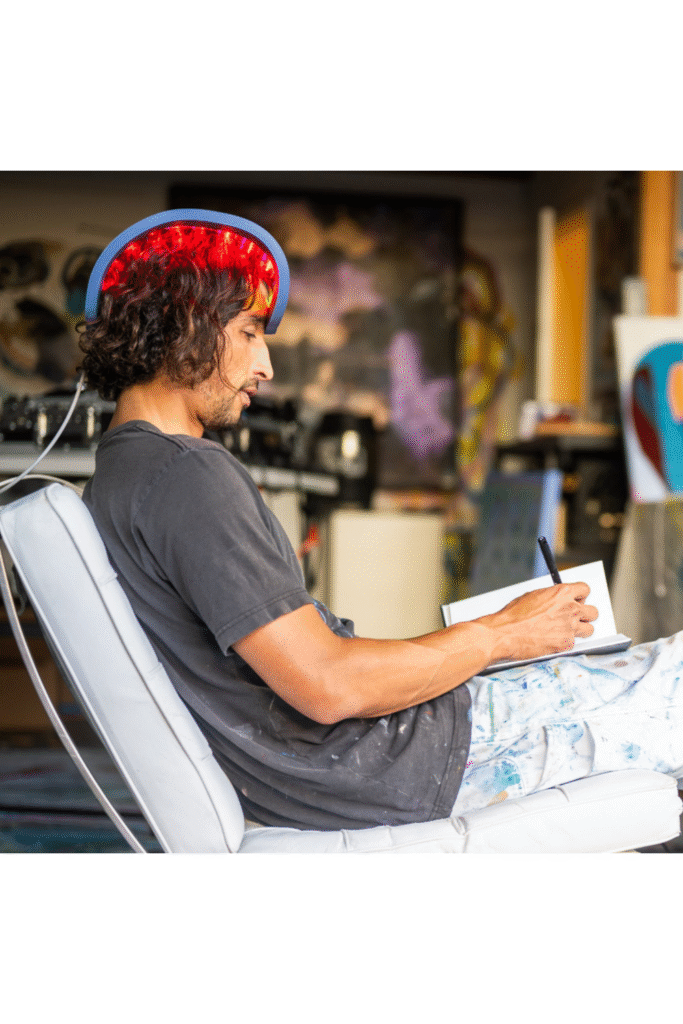
Many at-home users (myself included!) use red and near-infrared light on areas like the scalp to help stimulate hair follicles, or on the stomach and thighs to support skin elasticity and firmness.
While these aren’t FDA-cleared uses for the Pro version, Celluma does offer a panel specifically designed for hair regrowth:
🧠 Celluma RESTORE – FDA-cleared for hair loss treatment, targeting the scalp with therapeutic red light wavelengths
📚 Celluma has published research showing that red and near-infrared light may stimulate dormant hair follicles and improve skin texture, which matches what many users—including myself—experience with regular use.
👙 My experience: I’ve personally used my Celluma Pro on my thighs and stomach to help with skin tone and firmness. It’s not an overnight transformation, but with consistency, it absolutely helps my skin feel smoother and more resilient.
Summary: Whole-Body Red Light Benefits
| Area | Benefit |
|---|---|
| Inflammation | Calms swelling + speeds healing |
| Energy & mood | Boosts mitochondria & ATP |
| Pain & recovery | Soothes joints & muscle soreness |
| Hair & body skin | Supports regrowth + elasticity |
🛑 What to Know Before You Try It
Okay, I’m intrigued… but is this realistic for me?” Let’s talk about what to know before getting started.
Here’s the honest truth: it’s not a miracle fix. It’s a tool—and like any tool, it works best when you understand how (and when) to use it. After years of seeing it in a clinical setting and using it in my own home, I’ve learned a few key things that can save you time, money, and frustration.
1. Consistency is everything.
You need to remember that red light therapy works cumulatively, not instantly. Most studies (and real-life users) report visible skin and wellness improvements after 4 to 12 weeks of consistent use.
- For skin: Aim for 3–5 sessions per week, about 10–20 minutes
- For acne or inflammation: You may need more frequent sessions at first
- For energy and mood: Many people feel subtle improvements within 2 weeks
🧡 Think of it like taking vitamins—you don’t notice dramatic changes overnight, but it’s doing good work under the surface.
2. Not all red light devices are created equal.
Put simply, there’s a big difference between a high-quality, clinical-grade panel and a $30 light-up mask.
Here’s what matters most:
- Wavelengths: Red (630–660nm) and near-infrared (810–850nm) are the most studied
- Irradiance: This measures the light’s intensity. Too weak = no effect. Too strong = potential discomfort.
- Treatment area: Larger panels cover more of your body efficiently
- FDA clearance: Especially important for safety and reliability
💡 I use the Celluma Pro, which is FDA-cleared and was used in the medical spa where I worked. It has red, blue, and near-infrared settings—so it covers skin, acne, inflammation, and muscle recovery all in one device.
3. It’s not a replacement for your skincare or wellness habits.
Think of it this way: red light therapy enhances what you’re already doing—it doesn’t replace sunscreen, hydration, a healthy diet, or a good cleanser.
What it can do is:
- Make your skincare products work better (by improving circulation + absorption)
- Calm inflammation so your skin can heal more easily
- Support your energy and mood to stay consistent with your other habits
🧘♀️ The best results come when red light therapy is part of a bigger picture—like a calm nighttime routine, a consistent skincare ritual, or a gentle recovery plan after a workout.
4. It’s not for everyone, and that’s okay.
People with certain light sensitivities, active cancers, or medications that increase photosensitivity should always talk to their doctor first. And if you try it and don’t love it? That’s fine too. Not every wellness tool works for every body.
🛒 click image to shop:
🕯️How I Use Red Light Therapy in Real Life
Wondering what this actually looks like in real life? Here’s how I use red light therapy in my daily rhythm—nothing fancy, just doable. For me, red light therapy for skin and body has become one of those quiet, grounding moments I genuinely look forward to. It’s not elaborate or time-consuming—but it helps me feel centered before the busyness of the day begins. More importantly, it gives me a moment to check in with myself instead of rushing headfirst into the chaos.
🌞 Mornings: Calm Start, Clear Mind
Right after I wake up, I head to the bathroom to quickly wash my face—just a gentle cleanse, no fuss. Then I lay down or sit comfortably and use the Celluma Pro for about 15 to 30 minutes while the house is still quiet.
No scrolling. No multitasking. Just light and breath.
Sometimes I close my eyes and reflect. Other times I mentally walk through my to-do list or set an intention for the day. It’s like easing into the morning instead of being jolted into it.
- Red + near-infrared light across my face and neck
- No products underneath—just clean skin
- A simple way to wake up with clarity and purpose
☀️ I usually don’t even drink my hydration mix or make breakfast until after this—it gives me space to fully arrive in the day.
🛋️ Midday or Evening: Body Care While Life Happens
Later in the day, I’ll often use the Celluma again—this time on my thighs, stomach, lower back, or shoulders, depending on what needs support. I love that I can use it while doing completely normal things:
- Working at my desk
- Watching a show in the evening
- Listening to a podcast
- Chatting with my kids
It’s really flexible and lightweight, so it can lay across wherever I need it—and I don’t have to “pause life” to do it.
👩👧 Teen Acne Tip: Blue Light Sessions for the Win
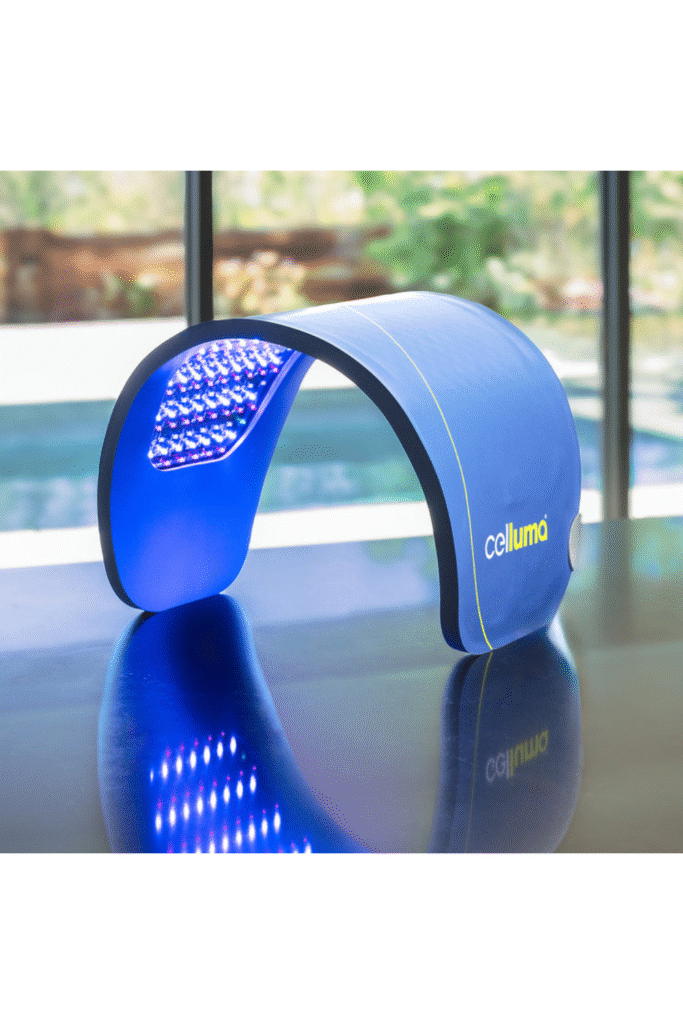
My teens use the blue light mode on the same panel a few times a week to help manage breakouts. It’s one of the few things that consistently helps reduce their acne without irritating their skin.
Where was this when I was in high school?!
✨ Real-life tip: You don’t need a spa setup or perfect playlist. Just leave the panel somewhere visible and easy to grab—and treat it like brushing your teeth. It becomes second nature once it’s part of your flow.
💡 Tips for Choosing a Device + Starting Your Routine
Red light therapy works—but only if your device does too. So, whether you’re brand new or looking to upgrade, here’s what to keep in mind before clicking “add to cart.” The good news is, you don’t need to be a scientist to understand this stuff—just a few key terms can go a long way. Even so, there are definitely a few things I wish I’d known before buying my first device.
🔬 What to Look for in a Red Light Therapy Device
🟥 Wavelengths that work:
Look for devices that emit red light (around 630–660nm) and near-infrared light (around 810–850nm). These are the most well-studied for skin, pain relief, and inflammation.
💡 Tip: Blue light (around 415nm) is great for acne—it’s what my teens use with the Celluma Pro.
⚡ Irradiance matters:
This measures how much light energy reaches your skin. Too low and it won’t do much. Too high and it might be uncomfortable. Clinical-grade panels (like Celluma) are calibrated for safety and effectiveness.
📐 Treatment area + design:
Bigger isn’t always better—but you want something that fits your lifestyle. Do you want a full panel? A flexible pad? A targeted wand for small areas? I personally love the Celluma Pro because it’s curved, hands-free, and versatile.
✅ FDA clearance:
This is a big one. If a device is FDA-cleared, it means it’s been reviewed for safety and effectiveness—not just flashy marketing. Celluma has multiple panels cleared for pain, acne, wrinkles, and more.
👉 Explore Celluma’s full line here if you’re curious—they now offer hair growth and fat contouring panels too (RESTORE + CONTOUR).
🛒 click image to shop:
🕒 How to Start: A Beginner-Friendly Red Light Routine
The best part? You don’t need a full-blown wellness schedule.
Here’s a simple starting point:
- Start with clean skin—no makeup or thick serums
- Use 3–5 times per week for 10–20 minutes
- Stay consistent—results build slowly over weeks
- Be patient—glow, clarity, and healing take time
✨ The goal isn’t perfection—it’s creating a rhythm that feels supportive and doable.
🌿 Final Thoughts: Red Light Therapy as a Gentle Wellness Ritual
Whether you’re brand new to red light therapy or just needed some clarity, I hope this gave you helpful insight. Let’s wrap it up with a few final thoughts.
Red light therapy for skin and body isn’t a quick fix or a magic cure—but it is a powerful tool that supports your skin, your body, and your energy from the inside out. So, whether you’re using it to calm breakouts, support post-workout recovery, or just sneak in a few minutes of peace in a busy day, it works best when it becomes part of your rhythm—not another thing on your to-do list.
I’ve seen it used in clinical settings. I’ve used it in my own home. Better yet, I’ve watched my teens benefit from it, too. The truth is, it’s one of those wellness habits that’s easy to stick with once you experience how it makes you feel.
So if you’re curious, start simple. Start slow. And most of all—make it your own.
👉 If you’re building your summer skincare routine, you might also enjoy my post on minimalist summer makeup essentials.

